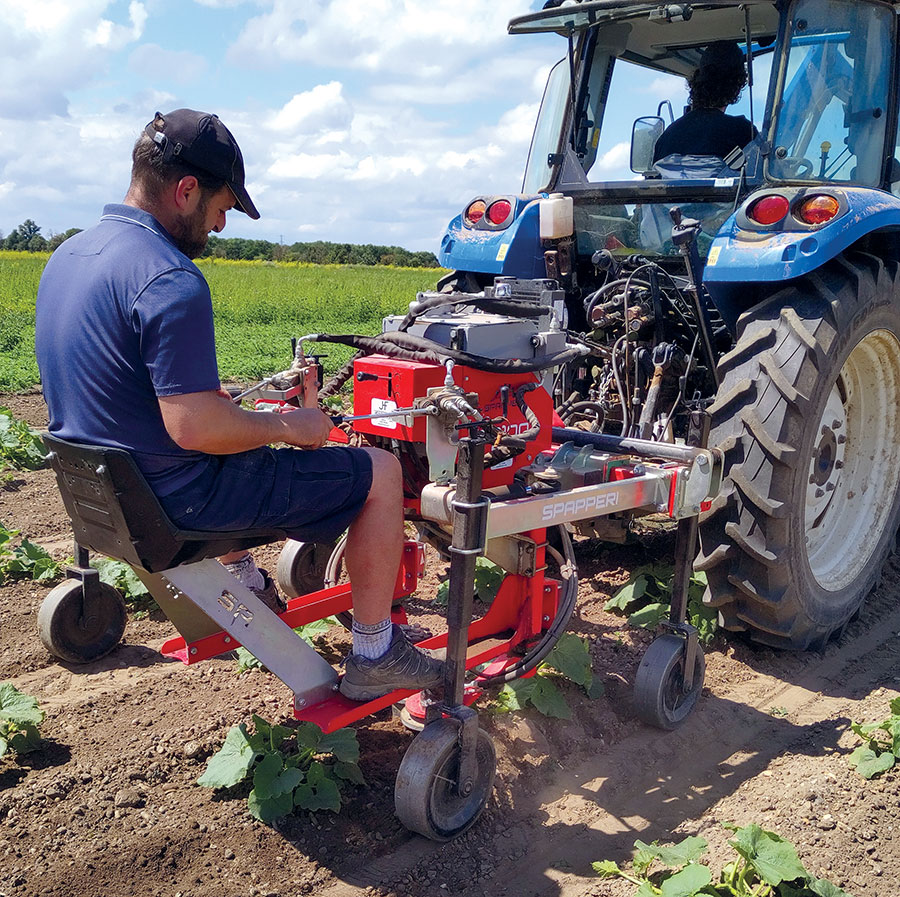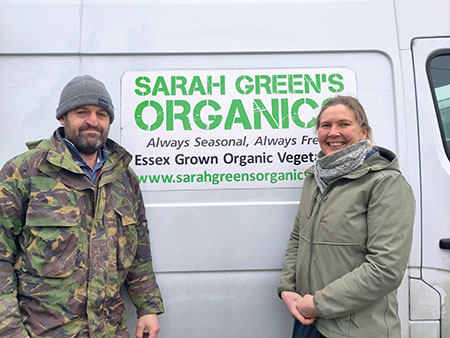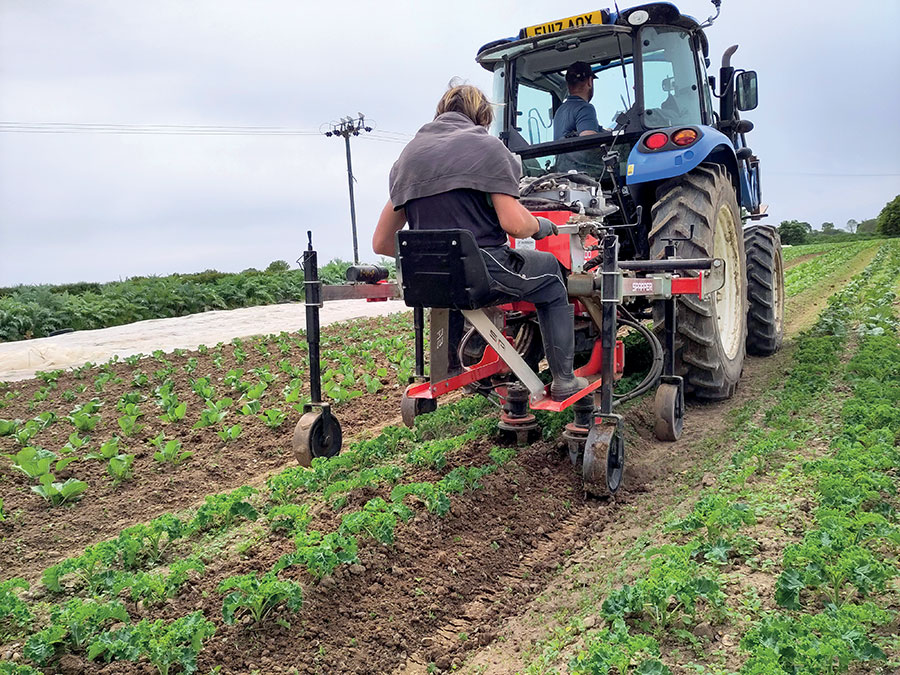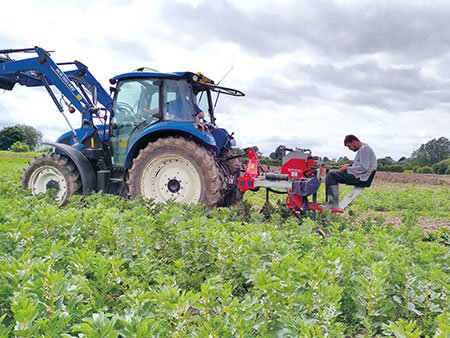Time and labour savings
15th April 2024
An Essex-based, organic salad and vegetable grower says that a tractor-mounted, operator controlled rotary weeder is providing an effective and accurate inter-plant weeding solution – allowing two people to do the work of five, and in half the time. David Williams reports.

Trading as Sarah Green’s Organics, Sarah Green is the third generation of her family to farm at Tillingham. She runs the highly successful enterprise with her parents, Steven and Sally, and her husband Stuart. The company specialises in supplying vegetable boxes which local customers collect or have delivered, and it also grows and supplies fresh harvested produce for vegetable boxes retailed through independent businesses, as well as to London-based customers via the Better Food Shed. A twice-weekly inner London delivery service supplies produce wholesale to gastropubs, restaurants and shops. In 2023, a pick-your-own pumpkin patch growing pumpkins and squash organically on three hectares was added, and the successful venture will be repeated this year.
Approximately 30ha of land is certified organic by the Soil Association and crops are grown on a six-year rotation. Seasonal vegetables are grown on 12ha – lettuce, tomatoes, courgettes, beetroot, spring onions, and new potatoes in the summer months, and kale, cabbages, Brussels sprouts, cauliflowers, leeks, purple sprouting broccoli, swede and celeriac in the winter.
Year-round supply
Because most of the produce is retailed, a regular supply is required through the season. “Our fields are a real patchwork of vegetables, with just a few beds of a variety planted at a time,” explained Sarah. “Field-scale vegetables require regular weeding which is why we invested in the mechanical weeder, and these include cauliflower, cabbages, kale, Brussels sprouts, purple sprouting broccoli, leeks, radicchio, chard, beetroot, swede, kohlrabi, courgettes, squash and pumpkins. Because we don’t grow acres and acres of these crops in a single area, our system is less suited to robotic weeding. The crops are in rows which means we can use our tractor-mounted brush weeder or steerage hoe, but these only weed between the rows, so gaps between the plants remain a problem.”
Camera systems unsuccessful
Camera-guided robotic weeders were trialled but proved unsuccessful, explained Stuart. “Because such a wide variety of crops are grown in relatively small batches, camera systems struggle with the frequent changes in crop colour, height and stature.
“Experience has proven that the ‘eye doesn’t lie’ computer systems are easily confused by variations within our beds, but when we tried the Spapperi weeder which relies on an operator’s judgement to activate the inter-plant hoe weeding units, the results were pretty much faultless.”
Seen in Farmers Guide

The Spapperi weeder was purchased from UK importer JF Hudson Ltd in January 2022, for the start of the growing season. “My father-in-law saw the Spapperi weeder advertised in Farmers Guide magazine, after which we contacted James Hudson at JF Hudson and requested a demonstration,” continued Stuart. “That was late in 2021, at the end of the season when there were few areas of crops suitable for the trial, but we tested it in cauliflower and kale which had been overwhelmed by the weed population, and the results were extremely promising.
“We found the JF Hudson team very helpful from arranging and carrying out the demonstration to arranging delivery, and since then they have always been happy to provide support.”
Specialist manufacturer
Spapperi offers a wide range of specialist machinery including its Inter-Plant and Inter-Row mechanical weeders. Inter-Plant weeders are available in versions of one to four row widths, and adjustable row spacing allows use in a wide variety of salad, vegetable and fruit crops.
A single row model with a hydraulic headstock was selected by the Green family, as this was considered the best option for working in the tight, 38cm row spacing. The headstock is easily adjusted on the move to align the weeding units with the plant rows, and the two hydraulic-activated and powered rotating hoe units are moved in and out between plants by a pair of levers. The integral hydraulic system uses an on-board pump driven by the tractor PTO, which means that the unit is practically self-contained and suitable for use with smaller tractors, including those with less powerful hydraulic systems. No complex computer software is involved.
Simple operation
“Only two people are required to operate it,” explained Stuart. “The downside to the single row model is that three passes are needed to weed each bed, which takes extra time; but, even so, half a day on the Spapperi weeder replaces a full day of hard hand-weeding by five people.”
Stuart said that operation is simple, and the seat provides a comfortable working position as the operator sits straight rather than being bent over. The hydraulic operating levers are light and easy to use, and the job requires a lot of concentration so time passes quickly. “It’s user-friendly and there is no repetitive strain – everyone prefers it to hand weeding,” he confirmed.
Variable plant spacing no problem
Plant spacing depends on the crop, so it varies considerably across the farm. “Some summer crops grow fast enough or are close enough together so that only a pass with our brush weeder is needed which is obviously cheaper and quicker,” continued Stuart. “For other crops where the Spapperi will always be the better solution, we have increased spacings in some cases from 20cm to 25cm to allow faster working with less collateral damage. Ground conditions must be reasonable, and if seedbeds are good then the Spapperi works brilliantly – whereas if the ground is too compacted, very wet or stony then we resort to conventional weed control methods.”

Added reassurance
Sarah commented that fat hen is prolific in some fields, while high populations of red shank can also be problematic. “Both these weeds grow quickly whatever the weather and can quickly suppress crops if they get a hold in the rows,” she stressed.
“Knowing that the Spapperi can still rescue crops at that stage is a relief, but it’s a situation that we still do our best to avoid.”
Stuart added that the Spapperi has proved surprisingly versatile. “When we can use it at the ideal time then work is easy, and speeds can be increased. However, we have all been surprised by its ability to work in closer-spaced crops such as leeks and broad beans. Depending on the weeding head rotation direction selected, we can use it to create ridges which stifle small, in-row weeds. It’s proved ideal for pumpkins in the new pick-your-own pumpkin patch.”
Easier management and improved timeliness

Asked what difference investment in the Spapperi weeder has made to the business, Stuart explained that the main benefit is that it releases people from weeding duties leaving them free to carry out other tasks and improves timeliness. “Our small team can carry out harvesting, planting or irrigating while weeding continues elsewhere. It’s much easier to spare two people for weeding than five, and the Spapperi doesn’t depend on one highly skilled operator and advanced computer software as would be needed for a camera-guided robotic machine, so it suits us much better. It’s also easy to hitch and unhitch from our tractors and can be used on any of them, so it doesn’t tie up one tractor for the season.”
“The fact that anyone can operate the Spapperi on the back of the tractor is a real advantage and it fits in well with us and our team. Also, because operating the machine is so comfortable, we find our team members are happy to put in extra hours when required.”
Read more machinery news
